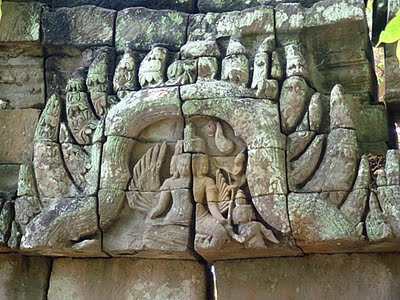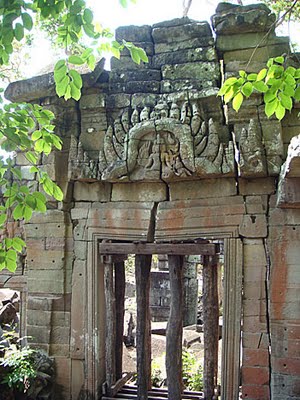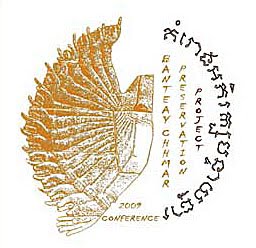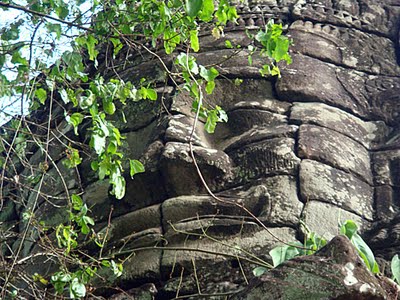Spotlight on Banteay Chhmar
Banteay Chhmar is a fascinating temple complex in northwest Cambodia. It's a temple built during the rule of King Jayavarman VII in the 13th century and unlike the temples constructed at Angkor around the same time, it didn't suffer the iconoclasm that engulfed temples such as the Bayon and Ta Prohm, where Mahayana Buddhism images were chiselled away and defaced after the King's reign came to an end. To that end, Banteay Chhmar can reveal a lot more about the time and beliefs of Jayavarman VII than other sites. That's if it was still in pristine condition. It's not. It too has suffered the ravages of time and temple thieves and only 25% of its bas-reliefs are still standing. The rest lie in pieces on the floor or have been stolen and lost forever.
The Global Heritage Fund and its many partners are now trying to piece the temple back together again. Stone by stone, carving by carving. Last year they held their 2nd conference about the temple in Sisophon and you can find out much more about the project to renovate and restore Banteay Chhmar from the video-papers presented by various speakers here. One of the speakers was Dr Peter Sharrock, a scholar from the University of London, who had his own view on the identity of the giant face that stares out from the face towers of Banteay Chhmar, the Bayon and elsewhere. He discounts the possibility that it is the face of Jayavarman VII himself or the Avalokiteshvara, which is often stated in guidebooks and the like and instead suggests the face belongs to the tantric deity of Vajrasattva. "I think its the supreme deity presiding over a tantric cult of Hevajra. I said Vajrasattva in my chapter in Joyce Clark's book Bayon, New Perspectives in 2007 and nobody has yet argued against this analysis. Let's wait and see. Hevajra is a fierce emanation of Vajrasattva, who is more of a primordial conception than a god you could picture or address," he told me by email today. If that's the case, and proving it will solve one of the key mysteries that still envelope Angkor, then every book on Angkor will need to be updated.
Sharrock also highlights a carving at Banteay Chhmar that he believes is the first representation of Hevajra in stone, rather than the more common statues of the deity in bronze. This is of massive importance to understanding more of the Buddhism promoted by Jayavarman VII and is one way in which Banteay Chhmar can tell scholars so much more about that period of Cambodian history, which fascinates so many. The secrets of Banteay Chhmar are still waiting to be discovered. I've written an essay on the temple for my book To Cambodia With Love, which should be out in June, as it's one of the ancient temples that I have a close affinity with, after my first visit there in November 2001.
 Scholar Peter Sharrock believes this carving at Banteay Chhmar is of the deity Hevajra, with 20 arms and 9 heads. A smaller figure below has 5 heads.
Scholar Peter Sharrock believes this carving at Banteay Chhmar is of the deity Hevajra, with 20 arms and 9 heads. A smaller figure below has 5 heads.
 The carving is above a doorway that is unstable and will be one of the tasks of Global Heritage Fund to ensure that this wall is safely preserved
The carving is above a doorway that is unstable and will be one of the tasks of Global Heritage Fund to ensure that this wall is safely preserved
The Global Heritage Fund and its many partners are now trying to piece the temple back together again. Stone by stone, carving by carving. Last year they held their 2nd conference about the temple in Sisophon and you can find out much more about the project to renovate and restore Banteay Chhmar from the video-papers presented by various speakers here. One of the speakers was Dr Peter Sharrock, a scholar from the University of London, who had his own view on the identity of the giant face that stares out from the face towers of Banteay Chhmar, the Bayon and elsewhere. He discounts the possibility that it is the face of Jayavarman VII himself or the Avalokiteshvara, which is often stated in guidebooks and the like and instead suggests the face belongs to the tantric deity of Vajrasattva. "I think its the supreme deity presiding over a tantric cult of Hevajra. I said Vajrasattva in my chapter in Joyce Clark's book Bayon, New Perspectives in 2007 and nobody has yet argued against this analysis. Let's wait and see. Hevajra is a fierce emanation of Vajrasattva, who is more of a primordial conception than a god you could picture or address," he told me by email today. If that's the case, and proving it will solve one of the key mysteries that still envelope Angkor, then every book on Angkor will need to be updated.
Sharrock also highlights a carving at Banteay Chhmar that he believes is the first representation of Hevajra in stone, rather than the more common statues of the deity in bronze. This is of massive importance to understanding more of the Buddhism promoted by Jayavarman VII and is one way in which Banteay Chhmar can tell scholars so much more about that period of Cambodian history, which fascinates so many. The secrets of Banteay Chhmar are still waiting to be discovered. I've written an essay on the temple for my book To Cambodia With Love, which should be out in June, as it's one of the ancient temples that I have a close affinity with, after my first visit there in November 2001.
 Scholar Peter Sharrock believes this carving at Banteay Chhmar is of the deity Hevajra, with 20 arms and 9 heads. A smaller figure below has 5 heads.
Scholar Peter Sharrock believes this carving at Banteay Chhmar is of the deity Hevajra, with 20 arms and 9 heads. A smaller figure below has 5 heads. The carving is above a doorway that is unstable and will be one of the tasks of Global Heritage Fund to ensure that this wall is safely preserved
The carving is above a doorway that is unstable and will be one of the tasks of Global Heritage Fund to ensure that this wall is safely preserved Labels: Banteay Chhmar, Peter Sharrock, To Cambodia With Love




1 Comments:
For a look at Banteay Chhmar in 1937, visit the Devata.org website of Kent Davis. Find it here:
http://www.devata.org/2010/01/banteay-chhmar-1937-ancient-khmer-city-in-cambodia/
Post a Comment
<< Home